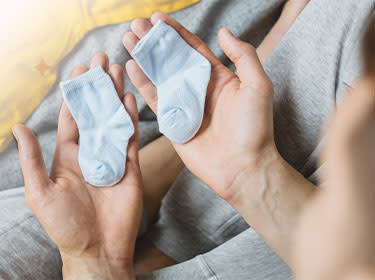How do baby clothes sizes work?
Clothes sizes for babies are typically labeled by age. Depending on the brand of clothing, some of the sizes you can expect to see are:
P (Preemie)
N (Newborn)
0-3 months
0-6 months
3-6 months
6-9 months
9-12 months
12-18 months
18-24 months
2T (2 years)
3T (3 years)
4T (4 years)
5T (5 years)
6T (6 years)
Each child is unique and grows at her own pace, so trying to buy clothes that fit and last more than a single wear can be a challenge. Size differences between brands occur because brands design their baby clothes sizes by weight for each age group. This means some clothes may fit your baby perfectly within their age range while others will be too large or too small.
The most important thing to note with respect to sizes is that they represent an average range, and the size listed will be the upper limit of that range. So, if you have a 3-month-old, they will likely be ready to graduate from 0-3 month sizes into 3-6 month sizes if they haven't already. When in doubt, it's best to size up. Babies grow fast and pants and sleeves can be rolled up if an item is too big for your little one.
Baby clothes sizes charts
When it comes to baby clothes, not all sizes are the same. That’s why it’s always important to check each brand’s size charts to make sure you pick out clothes that fit right the first time. And to make things easy, we’ve put together a list of all the top baby clothes brands with sizing.
OskKosh Sizing¹:
Amazon Essentials Sizing²:
Gerber Sizing³:
Old Navy Sizing⁴:
Cat & Jack Sizing⁵:
*Size specs are approximations based on average baby size pulled from sizecast.com
Carter’s Sizing⁶:
How long do babies fit in newborn clothes?
This will depend on your baby, but typically infant clothing sizes fit for 4-6 weeks after you bring him home from the hospital. It can be confusing to determine the difference between Newborn and 0-3 month clothes, but typically Newborn sizes cover babies in the 5-8 pound range while the 0-3 month sizes fit 8-12 pound children. Each baby is different and grows at their own pace, so don't be alarmed if your baby quickly outgrows Newborn sized clothes. If your little one is in a higher percentile for weight or height, they may even be wearing 0-3 month clothes home from the hospital! Expecting parents should also keep in mind that new babies are messy. Everything from diaper blowouts to spit up to spilled bottles means you’ll be washing a lot of baby clothes [link to: https://dreft.com/en-us/washing-tips/washing-baby-clothes/how-to-wash-baby-clothes ] once she arrives. Repeated washes will shrink clothes, so it's important to pay attention to your wash and dry cycles [link to how to dry baby clothes] to reduce shrinkage and buy extra clothing if needed.
How to buy baby clothes?
Try before you buy When possible, shop for baby clothes in person. This will allow you to see and feel the clothes and get an idea for the size of something before you buy. Just because your baby fits into a 3-month romper in one brand doesn't mean she will in another, so shopping in person can prevent unwanted purchases.
Size up As a rule of thumb, it's best to buy big. Your baby will grow quicker than you think and you can always roll up sleeves or pants on too-big items and let your baby grow into them over time. Who knows… you may find that an item that is at first too-big fits just right after a run through the wash.
Wash Before Wear Whether you bought new baby clothes or got them secondhand, it’s always important to make sure anything that touches your little one’s skin is properly washed to remove dirt, stains or anything you might’ve missed. Dreft [link to https://dreft.com/en-us/shop-products] baby detergent is perfect for this, because it has the power to remove stains, while being gentle on delicate skin.
Frequently Asked Questions About Baby Clothes
Buying clothes for your baby is exciting and fun, even if it’s a little confusing at first. Now that you know how to read size labels and have explored some of the brands available to your child, keep what you’ve learned in mind as you begin to prepare. Shop in person and follow your checklist to prevent overbuying and unwanted purchases from making it into your baby’s closet and dresser drawers!


